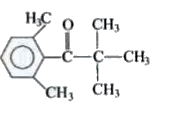Methyl oxirane on reaction with , followed by hydrolysis, gives alcohol. By which of the following mechanisms does the reaction proceed ?
The correct Answer is:B
To determine the mechanism by which methyl oxirane reacts with methyl magnesium bromide (CH₃MgBr) followed by hydrolysis to form an alcohol, we can follow these steps:
Step 1: Identify the Reactants
Methyl oxirane is an epoxide, which is a three-membered cyclic ether. The structure of methyl oxirane is as follows:
OCH3CH
Step 2: Reaction with Methyl Magnesium Bromide
When methyl oxirane reacts with methyl magnesium bromide (a Grignard reagent), the nucleophilic carbon (from the Grignard reagent) attacks the less hindered carbon atom of the epoxide. This is a characteristic feature of an SN2 mechanism, where the nucleophile attacks the electrophile and simultaneously displaces the leaving group.
Step 3: Mechanism of the Reaction
1. The nucleophilic carbon from CH₃MgBr attacks the carbon atom adjacent to the oxygen in the epoxide.
2. This results in the opening of the epoxide ring and the formation of a tetrahedral intermediate.
3. The oxygen atom becomes negatively charged, and the bond between the carbon and oxygen is broken.
Step 4: Hydrolysis
After the epoxide ring opens, hydrolysis occurs. The negatively charged oxygen will react with water (or H₃O⁺) to form an alcohol. The final product will be a secondary alcohol due to the formation of a new carbon-carbon bond.
Step 5: Final Product
The final product after hydrolysis is a secondary alcohol, which can be represented as follows:
OHCH3−CH−CH3
Conclusion
The mechanism by which methyl oxirane reacts with CH₃MgBr followed by hydrolysis is an SN2 mechanism, resulting in the formation of a secondary alcohol.
Methyl oxirane is an epoxide, which is a three-membered cyclic ether. The structure of methyl oxirane is as follows:
When methyl oxirane reacts with methyl magnesium bromide (a Grignard reagent), the nucleophilic carbon (from the Grignard reagent) attacks the less hindered carbon atom of the epoxide. This is a characteristic feature of an SN2 mechanism, where the nucleophile attacks the electrophile and simultaneously displaces the leaving group.
1. The nucleophilic carbon from CH₃MgBr attacks the carbon atom adjacent to the oxygen in the epoxide.
2. This results in the opening of the epoxide ring and the formation of a tetrahedral intermediate.
3. The oxygen atom becomes negatively charged, and the bond between the carbon and oxygen is broken.
After the epoxide ring opens, hydrolysis occurs. The negatively charged oxygen will react with water (or H₃O⁺) to form an alcohol. The final product will be a secondary alcohol due to the formation of a new carbon-carbon bond.
The final product after hydrolysis is a secondary alcohol, which can be represented as follows:
The mechanism by which methyl oxirane reacts with CH₃MgBr followed by hydrolysis is an SN2 mechanism, resulting in the formation of a secondary alcohol.
Topper's Solved these Questions
- GRIGNARD REAGENTS AND ORGANOMETALLIC REAGENTSBOOK - CENGAGE CHEMISTRY ENGLISHCHAPTER - GRIGNARD REAGENTS AND ORGANOMETALLIC REAGENTSEXERCISE - Exercises Archives (Single Correct)
4 Videos
- GRIGNARD REAGENTS AND ORGANOMETALLIC REAGENTSBOOK - CENGAGE CHEMISTRY ENGLISHCHAPTER - GRIGNARD REAGENTS AND ORGANOMETALLIC REAGENTSEXERCISE - Exercises Archives (True/False)
1 Videos
- GRIGNARD REAGENTS AND ORGANOMETALLIC REAGENTSBOOK - CENGAGE CHEMISTRY ENGLISHCHAPTER - GRIGNARD REAGENTS AND ORGANOMETALLIC REAGENTSEXERCISE - Exercises (Multiple Correct)
16 Videos
- GENERAL PRINCIPLES AND PROCESS OF ISOLATION OF ELEMENTSBOOK - CENGAGE CHEMISTRY ENGLISHCHAPTER - GENERAL PRINCIPLES AND PROCESS OF ISOLATION OF ELEMENTSEXERCISE - Archives (Subjective)
14 Videos
- NCERT BASED EXERCISEBOOK - CENGAGE CHEMISTRY ENGLISHCHAPTER - NCERT BASED EXERCISEEXERCISE - Nuclear Chemistry (NCERT Exercise)
29 Videos
Similar Questions
Knowledge Check
Cumene on reaction with oxygen followed by hydrolysis gives
ACH3OH and C6H5COCH3BC6H5OHand(CH3)2OCC6H5OCH3 and CH3OHDC6H5OH and CH3COCH3Which of the following ketone does not react with CH3MgBr?
ACH3−O∣∣C−CH3B CH3C−CH3∣C∣CH3−O∣∣C−CH3∣C∣CH3−CH3DPh−O∣∣C−CH3
CH3C−CH3∣C∣CH3−O∣∣C−CH3∣C∣CH3−CH3DPh−O∣∣C−CH3
The reaction of RCN with R'MgX, followed by hydrolysis gives
View Solution1-Ethyl-2-methyl oxirane when treated with C2H5MgBr, followed by hydrolysis gives :
View SolutionWhich of the following does not give lodoform reaction ?
View SolutionWhich of the following ketone does not react with CH3MgBr?
View SolutionWhich of the following does not give haloform reaction:
View SolutionWhich of the following reactions proceed at low pressure?
View Solution

